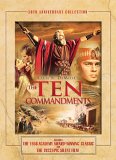Cecil B. DeMille’s The Ten Commandments hits store shelves in a new three-disc special edition, just in time for the release of the new made-for-TV mini-series. While the film classic is no stranger to DVD, it has yet to be released with this kind of gusto. At over three-and-a-half hours long, the film is simply too much for one disc to hold. The first disc contains the first 140 minutes, while disc two finishes up with the last 80. Plus, as a bonus, we get the original 136-minute silent version (also a DeMill… picture) on disc three. Since the later version is the most famous – and the centerpiece of this release – I will treat the inclusion of the silent version as a bonus feature.
Unless you’ve been living under a pyramid for the last 5000 years, you’re probably familiar with the story. Moses (Charlton Heston) grows up in the Egyptian palaces as a brother to Ramses (Yul Brynner). He discovers his true heritage as a Hebrew and forsakes all the riches and comforts of his childhood for the harsh life of a Hebrew slave. After killing an abusive Egyptian overlord (Vincent Price) in defense of a fellow Hebrew, he flees into the wilderness for about thirty years, until God decides it’s time for Moses to deliver the Hebrews from their plight. At first reluctant, Moses embraces the task at hand, and boldly marches back to Egypt for the famous showdown with the man he once called “brother.” Of course, the film takes certain liberties with the source material, but not so much to fall beyond the realms of reason. Moses really did grow up as an Egyptian, or so historians tell us, and so he must have had some deep ties to that people. DeMille does a fine job of honoring the text, while parlaying it into a compelling story of a house divided.
Words commonly used to describe this film: “grand,” “sweeping,” “achievement,” “amazing,” “spectacle” – I suppose they all apply, even though some of the special effects are dated (but not to the extent you might think), and the child actors are atrocious. But to fully appreciate the wonder that is The Ten Commandments, it helps to understand the time period in which it was made. Never before had someone made a film of such scope and magnitude. Dare I say that not even Gone With The Wind compares. And the crossover appeal of DeMille’s telling destined the film for success. Rather than hit too much on the religious aspects, the story is more about the evils of slavery, and how no man has a right to own another man. Now don’t get me wrong, the religious aspects are there, but the film functions perfectly fine as a secular fantasy adventure, in addition to being a historically accurate account for believers. For a nation not 100 years removed from the horrors of slavery, as well as being on the cusp of the Civil Rights movement, The Ten Commandments brought a lot of social value to the table, and that’s why it has endured as the masterpiece of a legendary filmmaker.
Video
The 1.85:1 anamorphic widescreen presentation shows very few flaws, with its most prevalent attribute being the rich colors. Grain is kept to a minimum, and while black levels never get a chance to show off their depth, the image is, overall, no worse for the wear. Yes, it does look like an older movie. But the good news? It looks like a clean, crisp, and colorful, older movie, which has received plenty of TLC over the years.
Audio
It’s good to see Paramount has forsaken the urge to sweep in with a bold, manufactured 5.1 track. (Believe me, they could have.) We do get a 5.1 track, but it’s more authentic and subtle than expected, although a bit tinny in places (especially in scenes where God speaks to Moses). The Red Sea crossing is the major set-piece here, and Elmer Bernstein’s score captures the drama and spectacle beautifully.
Special Features
The six-part documentary The Making of The Ten Commandments isn’t quite what I was hoping for. There are some interesting tidbits, but I expected more. It simply scratches the surface of the film, and ignores so many avenues, which could have added value to the package. The trailers, which include the original, a “making-of” teaser, and the 1989 re-release, are too brief to be considered anything more than novelty. I did enjoy the 1923 Silent Version, even though time has not been kind to its 1.33:1 presentation. Still – a grand motion picture, even then, which cried out for a super-budgeted revisit. Last but not least, is the insightful, entertaining feature-length commentary from Katherine Orrison, author of Written in Stone: Making Cecil B. DeMille’s Epic, The Ten Commandments. Ms. Orrison, a real trooper, provides commentary for both feature films.
Final Thoughts
The Ten Commandments, as presented in the 1956 version, would stand only a slim chance of seeing the light of day, if it were a project fighting the current Hollywood system. In fact, a slim chance might even be giving Hollywood too much credit. DeMille’s feat of landing such a terrific cast, and acquiring a budget large enough to pull off his spectacle was a miracle, even then. This day-and-age, it would be an accomplishment on par with parting the Red Sea long enough for a whole tribe of people to cross. Doable? That depends on your faith. As for me, I like to think all things are possible. In fact, I think my faith is the only thing that keeps me thinking Hollywood might one day pull off another great accomplishment such as this. Great picture, good sound, above average package of bonus materials – at under twenty bucks, why not?
Special Features List
- 1923 Silent Version
- The Making of The Ten Commandments 6-Part Documentary
- Trailers
- Audio Commentary





